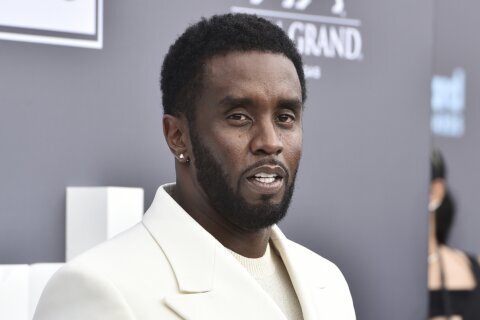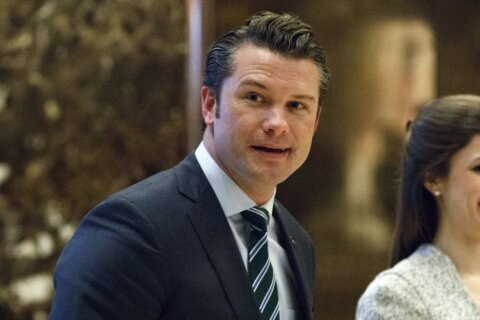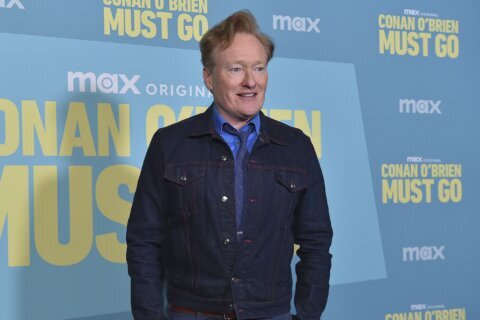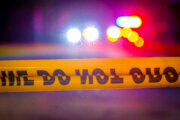WASHINGTON — He’s directed some of the finest films in all of world cinema, be it fiction like “Fitzcarraldo” (1982) or documentaries like “Grizzly Man” (2005).
Over the weekend, legendary filmmaker Werner Herzog was honored at AFI Docs’ Guggenheim Symposium, an annual honor saluting the most important filmmakers to ever grace the medium.
Confident, quirky and brilliant, the German genius sat down with WTOP before the big honor.
“I appreciate to be in Washington D.C. I haven’t been here for a while, and I find it an impressive place,” Herzog said. “Unfortunately, never [here for a] long time, maximum like three days. I’ve never really stayed here for more time, and in a way, it’s not right. I should be here [for a] longer time.”
While other symposium honorees have come before him, Herzog doesn’t like to think of himself as a product of any other filmmaker, insisting that his only influence comes from his own personal vision.
“Nobody has inspired me because I hardly see any films,” Herzog said. “I knew I was a poet and I would do films and they would be much better than everything around. … Since I had no knowledge cinema even existed until I was 11, I always had the feeling I’m the inventor of cinema. Until today, I make films as if I had invented it. … We are inventing cinema right here and now. That’s what we do.”
In many ways, he did.
After about a dozen shorts, docs and indie features, the West German filmmaker saw his global breakthrough masterpiece with “Aguirre: Wrath of God” (1972). Set in the 16th century, the “fiction” film starred Klaus Kinski as an insane, ruthless conquistador leading a Spanish expedition into Peru in search of El Dorado. The film was powerful for its social themes and its gritty documentary style.
“It’s all movies for me, simple as that,” Herzog said. “The line is not that clear and it’s in a way blurred.”
A decade later, Herzog returned to the Peruvian jungle for “Fitzcarraldo” (1982), casting Kinski as an opera enthusiast who dreams of pulling a steamship over a mountain in order to mine the rubber trees. The film won Best Director at the Cannes Film Festival but was infamously difficult to shoot.
“‘Fitzcarraldo’ was not a crazy shoot,” Herzog said, “It was just haunted by complications and catastrophes, real ones like two plane crashes, or the whole film ending up at the front of a border war between Peru and Ecuador. My camp was attacked by a thousand people and burnt down.”
The hardships were immortalized in the making-of doc “Burden of Dreams” (1982), similar to “Hearts of Darkness: A Filmmaker’s Apocalypse” (1991) about the making of “Apocalypse Now” (1979). Both films told of influential outsiders entering the jungle to chase their goals — and sanity — down river.
“You have to understand that whatever is being thrown at me, I have to deal with it,” Herzog said. “There’s no chance to be broken by what is happening. At the same time, I’m a very professional person who looks at what the risks are out there. I do not need to explore my outer limits; that’s a very silly idea of extreme mountain climbers. … I’m a very professionally functioning person.”
Few films have chronicled the risks of on-location filmmaking like Herzog’s documentary “Grizzly Man” (2005), which won the Alfred P. Sloan Feature Film Prize at Sundance. The film explores the real-life tragedy of Timothy Treadwell and Amie Huguenard, a pair of grizzly bear activists who left the developed world to live beside the bears of Alaska, only to be killed and eaten by them in 2003.
To his credit, Herzog tastefully never shares the audio of the death footage — horrifically captured with the lens cap on — instead showing himself listening to the audio in front of Treadwell’s friend. Wearing headphones, Herzog visibly shudders before asking the friend to stop the tape. He asks her never to listen to the audio and insists that she burn the tape so that she can get on with her life.
“The main tragedy of Timothy Treadwell and his girlfriend … was a deep misunderstanding of what constitutes wild nature,” Herzog said. “For them, it was a Disneyzation of wild nature, that grizzlies are really nice, sweet teddy bears and you can sing songs to them and you can even hug them.”
Rather than exploit the tragedy for its horrific irony, Herzog skillfully finds the beauty in Treadwell’s intentions, however naive, all while suggesting a sort of fatalistic destiny to his demise. Herzog masterfully foreshadows the horrific event by showing a bumble bee that appears to have died while gathering nectar — dying in action of its life’s purpose, like Treadwell’s filming — and cleverly narrates observations of how the natural world exists before and after Treadwell enters and exits the frame.
If “Grizzly Man” showcased mankind’s yearning for our primal past, Herzog’s newest documentary “Lo & Behold” (2016) warns audiences that our digital present could breed an incompetent future.
“I’m personally somebody who doesn’t use cellphones, not because I’m nostalgic. I do not use it for cultural reasons,” Herzog explained. “I do not want to be available all the time. I do not want to examine the world through applications on my cellphone. … I do not want any hacker, be it a private person or a government agency, to know all the time where I am. … Nobody can track me down.”
He admitted that not all technology is negative, but that it must be used in moderation.
“I think we can derive a lot of joy through the internet and through our cellphones, but ultimately we have to create a filter, and we don’t have a clear idea what the filter [is],” Herzog said. “I use internet via my laptop, for example, but very limited. I use it for emails, sometimes when it comes to family on another continent I do Skype, and sometimes I look at Google Maps, but that’s basically it.”
Herzog spoke with disbelief about a colleague’s digital dependency.
“One of my editors has a girlfriend that visited him literally every day by car in Los Angeles and she’s only a mile and a half away, only three turns left or right, very simple,” Herzog said. “Her GPS system was down one day and she couldn’t find him. … She had no conceptual idea about a very simple pattern where she was and where he was. And she did it 40 times in the last 30 days!”
Such a sad state of dependence can be unhealthy for our society as a whole.
“There’s not enough preparation for a failure of the internet,” Herzog said. “It can be wiped out for quite some periods of time because, let’s say, massive solar flares. That would mean we can’t do any financial transactions anymore. You cannot buy a hamburger, because the cash register is connected to the internet. You cannot make any phone calls. … You cannot pump gasoline anymore. You cannot flush your toilet anymore. You have no drinking water from your tap. No light. Nothing.”
Herzog’s call to look beyond our cellphones is thematically in step with his previous work.
“‘Lo & Behold’ is not a singular film that is somehow out of line with what I have done before,” Herzog said. “Subjects like that have somehow always fascinated me.”
Consider his fascinating narrative film “The Enigma of Kaspar Houser” (1974), which won the Grand Jury Prize at the Cannes Film Festival by telling a mysterious true story from 1928 Nuremberg.
“A young man who was found in the street [after being] kept captive in a basement without light and without ever seeing a human being or a house or a tree or clouds or hearing human language, and all of a sudden, he’s exposed to the real world,” Herzog said.
Such an existential premise — recently explored by Brie Larson in “Room” (2015) — works on the philosophical idea of Plato’s “Allegory of the Cave.” In this light, consider Herzog’s “Cave of Forgotten Dreams” (2010), which won Best Documentary by the Washington Area Film Critics Association.
“[The film] examines the first 32,000 years [of] pictorial messages that we receive from Paleolithic people and the awakening of the human soul and the awakening of art and music,” Herzog said.
Ironically, after so many groundbreaking works of fiction and documentary, Herzog’s only Oscar nomination to date came recently for the documentary “Encounters at the End of the World” (2007), capturing the beauty of Antarctica and investigating the characters that live there.
In such extreme conditions, it’s important to have a clear vision so as to not waste footage.
“I see some films in front of me so clearly as if I were sitting in a theater,” Herzog said. “This is why I can write a screenplay so fast. I’ve never spent more than a week writing a screenplay. This is why I do not need to shoot that much. I see young filmmakers who come at me exuberant, ‘I shot 650 hours’ … and my heart is sinking. The market doesn’t allow this amount of wasting of time, energy and money.”
Of course, even best-laid plans require the flexibility of capturing happy accidents that may occur.
“A few weeks ago I was filming a volcano in Indonesia and all of a sudden there’s an eruption,” Herzog said. “Huge glowing blobs of lava are flying at you. You do not turn away and run. You do not duck. You look up in the air, you look at the trajectory and if it comes at you, you step out of the way. That’s the right thing to do. Looking straight in the face of danger … that has carried me over many films.”
Still, gutsy resolve is nothing without the courage of convictions. Herzog steadfastly believes that filmmakers should form a subjective opinion when approaching any given material, tossing out journalistic notions of objectivity to create a work of authorship, expression and statement.
“I have called it an ecstasy of truth, an ecstatic truth,” Herzog said. “Much of what you’re seeing today in documentaries is an extension of journalism. I think we should divorce ourselves. It should not be so completely fact-based. … In documentary filmmaking, we should look beyond what is factual and beyond what is a journalistic quest. … [That’s] totally OK, but it belongs more to television.”
If anyone knows the power of television, it’s Herzog, who’s found new life in TV pop culture.
“Having a guest role in ‘The Simpsons’ [was] my apotheosis in American pop culture,” Herzog said. “I had to ask, ‘Do they talk?’ … They said, ‘Are you pulling our legs? ‘The Simpsons’ are on television since 24 years!’ … They said, ‘Your voice doesn’t have to be cartoonish, just keep your accent.'”
From “The Simpsons” to “Parks and Recreation,” Herzog has an undeniable sense of humor.
“It is really funny,” he said. “The kind of humor that I have echoes very visibly … in almost all my films. There’s a lot of stuff to laugh [at]. It’s a very unusual type of humor, sometimes a very dark humor.”
That dark side can also make him a convincing screen villain.
“I have entered into the consciousness of wider pop culture by playing a villain in ‘Jack Reacher’ … an action film with Tom Cruise where I was paid handsomely for being frightening. I knew I could do that,” Herzog said with a smile. “Although in my private life, I’m absolutely not that kind of guy. My wife would testify and swear to you, to God, or to anyone that I’m a fluffy husband.”
How fluffy? In his spare time, Herzog admits he watches cute kitten videos on YouTube.
“Cats can be very crazy,” Herzog said. “Sixty-second crazy cat videos are delightful. … [If] I had a bad night, I want to see a cat video before I touch my coffee in the morning. It just makes you feel lighter.”
Listen below for the full conversation between Werner Herzog and WTOP’s Jason Fraley in a roundtable that included Jason Dick from CQ Roll Call, Pat Padua of DCist and Alan Zilberman of Washington City Paper:








